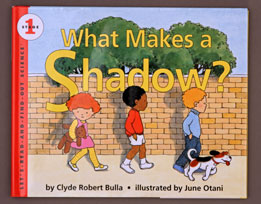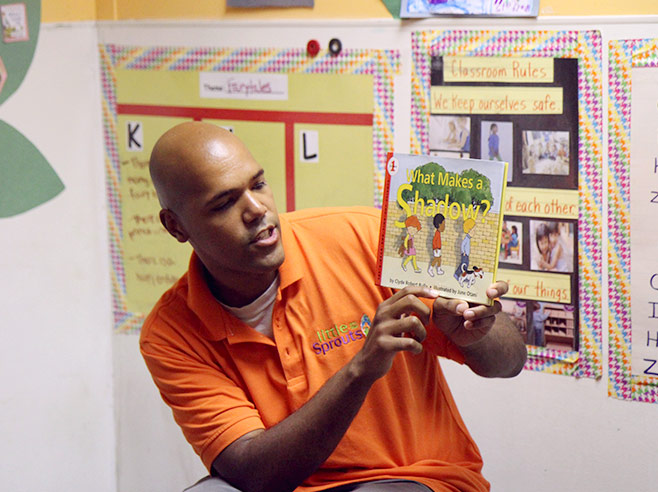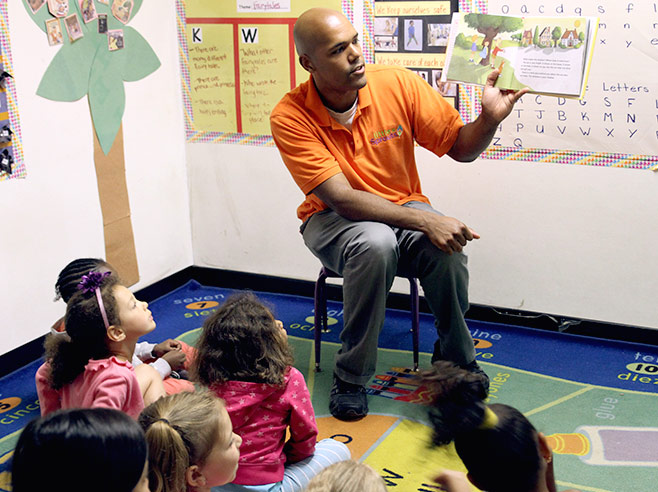Children listen to and discuss the book What Makes a Shadow? by Clyde Robert Bulla.
Materials

- Bright LED lamp
- Shadow surface (such as, blank wall, large chart paper, large poster board)
- What Makes a Shadow? by Clyde Robert Bulla
Preparation
- Familiarize yourself with the book What Makes a Shadow? Consider whether you might shorten the read-aloud session a bit by skipping pages 16–23.
- Set up a shadow area that includes a table, bright lamp, and a shadow surface.
Directions: Lesson 5
Circle Time: Wrap-Up
- Read the book What Makes a Shadow?
- Pause to examine the illustrations and to discuss the questions the author poses.
- For a shorter experience, you might read pages 3–15 and 24–32, skipping the section in the middle.
- After you discuss the illustrations on pages 24–27, ask children to summarize what they have learned. How can we make a shadow grow bigger or smaller?
- On page 28, pause and invite children to make the hand gestures for a hand shadow duck and rabbit. Children can try out these hand shadows again later in the Shadow Center.
Directions: Lesson 7
Circle Time: Introduction
- Revisit the pictures in the first half (pages 3–15) of the book What Makes a Shadow? Pause to examine and discuss the shadows, especially combined shadow shapes that are made by more than one person or object.
- Start with an example on page 5. Are the boy and girl touching in this picture?
- Are their shadows touching?
- Repeat the same question about the boy and girl on page 7, and the girl and the cat on page 15.
- Encourage children to discuss the following challenge: How do you think (name two children in the class) can make the shadows of their hands touch, even though their real hands are not touching?
- Let children offer predictions and suggestions.
- Then turn on the lamp so that it lights up a spot on the shadow wall.
- Invite two volunteers to demonstrate. Have them stand on either side of the light beam. Have one child hold his or her hand fairly close to the wall. Have the other child, hold his or her hand closer to the lamp.
- Have children compare the hand shadows. Which shadow is bigger? Smaller?
- Now have the two children explore making their “shadow fingers” touch, even though their real fingers are not touching.
- Let a second pair of children try too.
- Show the class page 29, which illustrates how to use two hands to make shadows that look like animals. Have children try using both hands to make a hand shadow that looks like a bird (first shadow on the bottom row). Can they move their hands and make the “wings” flap? Try making some other shadows as well.
- Show the class the last picture in the book (page 32). Possible discussion ideas:
- What do you see? What does the shadow look like? How do you think three children made a shadow that looks like an elephant?
- What is making the part of the shadow that looks like the elephant’s trunk?
- What is making the part of the shadow that looks like the elephant’s tail?
Directions: Lesson 8
Circle Time: Introduction
- Revisit the pictures in the first half (pages 8–15) of the book What Makes a Shadow? Pause to examine and discuss the shadows, especially combined shadow shapes that are made by more than one person or object.
- Start with an example on page 8. How many children are in this picture? How many of their shadows do you see?
- Why are there more children than shadows?
- What other shadows are touching on this page?
- Repeat the same question about the children, animals, and objects on the other pages.
Directions: Lesson 10
Circle Time: Wrap-Up
- Reread the book What Makes a Shadow? Pause to examine the illustrations and to discuss the questions the author poses.
- For a shorter experience, you might read pages 3–15 and 24–32, skipping the section in the middle.
- After you discuss the illustrations on pages 24–27, ask children to summarize what they have learned. How do we make a shadow? How can we make a shadow grow bigger or smaller?
- On page 28, pause and invite children to make the hand gestures for a hand shadow duck and rabbit. How did we make our shadows change? Children can try out these hand shadows again later in the Shadow Center.


